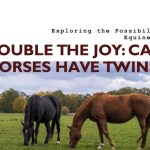How Long Can a Horse Live With Navicular? A horse with navicular disease can live a long and full life if it is properly managed. The most important factor in determining the length of a horse’s lifespan with navicular is how quickly the condition is diagnosed and treated. If detected early enough, many horses can be kept comfortable for years or even decades through proper management, including regular farrier visits, anti-inflammatory medications, shoeing changes to reduce pressure on the foot, corrective trimming, or shoeing techniques such as egg bar shoes or wedge pads.
Horses also need plenty of turnout time without excessive exercise to help manage pain levels while they are living with navicular. With good care, many horses that have been diagnosed with navicular disease go on to lead happy and productive lives for 10-20 years or longer.
Navicular disease is a progressive condition that affects the bones and soft tissues of horses’ feet. It can be a debilitating condition that causes pain, and lameness and can ultimately lead to early retirement from competitive sports or riding. The good news is that it often responds well to treatments such as rest, medication, farrier care, corrective shoes, and regular exercise.
With proper management, horses with navicular disease can live healthy lives for many years; however, each case will vary depending on how quickly the horse responds to treatment and how much damage has already been done to their feet.
When to Euthanize a Horse With Navicular
Euthanizing a horse with navicular can be an incredibly difficult decision to make, but ultimately it should come down to whether or not the horse is in pain and their quality of life. If there is no hope for improvement and your veterinarian has determined that the best course of action is euthanasia, then this option should be considered. However, if there are treatments available that could improve the horse’s condition such as corrective shoeing or medications, these should always be tried first before making any decisions about euthanasia.

How Long Will a Navicular Horse Last?
Navicular horses can suffer from a variety of conditions, most commonly navicular disease. This condition affects the small bones in the horse’s hoof, resulting in pain and lameness. The severity of this condition can vary from mild to severe, but even with proper veterinary care, it is difficult to predict how long a horse will last when suffering from navicular disease.
In general, horses diagnosed with mild cases may be able to perform light work for years while those with more advanced stages could have their careers cut short due to chronic pain and other related problems. Proper management of navicular horses is essential in order to minimize discomfort and maximize longevity; however, since there is no cure for the condition it ultimately comes down to individual case-by-case scenarios as far as how long an affected horse will last before being retired or euthanized.
Can a Horse Live With Navicular?
Navicular syndrome is a condition that affects the hoof of horses and can be painful and debilitating. The good news is that while this condition cannot be cured, it can usually be managed with proper care. This means that in many cases, a horse with navicular syndrome can still live a long and comfortable life if given the proper support from its owner or caregiver.
Treatment typically includes medications to reduce inflammation, corrective shoeing techniques to redistribute weight away from pressure points on the hoof, regular exercise for joint health and strength building, and not overworking your horse beyond his capabilities or limitations due to pain levels associated with navicular disease. In addition to these treatments, you may also want to consider supplementing your horse’s diet with vitamins such as Vitamin C & E which are thought to help aid in tissue repair within the heel area of their hooves. It is important for owners of horses suffering from navicular disease to provide them with extra TLC such as daily grooming sessions which will help keep circulation flowing throughout their bodies so they feel more comfortable during movement activities like walking or trotting around an arena.
Additionally providing ample turnout time will give them plenty of opportunity for natural stretching exercises letting their muscles move freely without any additional stress placed on them by riding activities. With the right management plan in place, it is possible for most horses living with Navicular Syndrome to have quality lives filled with lots of enjoyable experiences!
How Quickly Does Navicular Progress?
Navicular disease is an ongoing, progressive condition that affects horses. The speed at which navicular progresses varies from horse to horse, with the most severe cases progressing more quickly than those with milder symptoms. Generally speaking, however, navicular can progress steadily over time if left untreated.
In some cases, it may take months or years before the signs of navicular are evident while in others they may appear quite rapidly within a short period of time. Signs of navicular include lameness in one or both front legs; heat and swelling along the back of the foot just above the heel; a “stiff” gait caused by pain and fatigue; decreased performance due to discomfort during exercise; and difficulty turning corners due to stiffness or soreness. Treatment for this condition includes rest, proper shoeing to support weakened structures in the feet, anti-inflammatory medications such as Bute or Banamine®, joint injections with hyaluronic acid (HA) products such as Legend® or Adequan®, shock wave therapy and/or acupuncture treatments – all designed to reduce pain and inflammation associated with navicular disease.
What to Do With a Horse That Has Navicular?
Navicular Syndrome is one of the most common orthopaedic problems in horses, and it can be very frustrating for horse owners. Navicular Disease (also known as navicular syndrome) is a chronic degenerative condition that affects the coffin bone, which lies just beneath the sensitive structures of the foot including nerves and blood vessels. The exact cause of navicular disease is unknown but it usually occurs due to overloading or strain placed on the front feet from constant hard work such as show jumping, dressage, or competing in races.
As with any medical problem, early diagnosis and proper treatment are key to managing this condition successfully. Treatment typically consists of reducing inflammation through medications or injections, providing supportive hoof care including corrective shoeing or trimming, therapeutic exercises such as stretching and strengthening and cold water therapy. In some cases, surgery may be necessary to remove excess tissue within the navicular bursa (sac between tendon & bone).
It’s important to remember that each case is individual so your vet should always guide you on what would best suit your horse’s needs.
Navicular Syndrome Diagnosis: Case Example
Conclusion
Overall, it is clear that navicular disease can significantly decrease a horse’s lifespan. However, with proper care and management, horses with navicular disease can still live long and productive lives. With the right treatment plan, including supportive shoeing or therapeutic horseshoes and regular check-ups from a vet or farrier, horses with navicular can have comfortable and enjoyable lives for many years to come.
Janet G Kulick is an experienced horse rider, trainer, and owner of the informative horse blog, Horseray.com. Her engaging writing style and wealth of knowledge on horse care, riding, and training make her a trusted source for horse enthusiasts worldwide.






